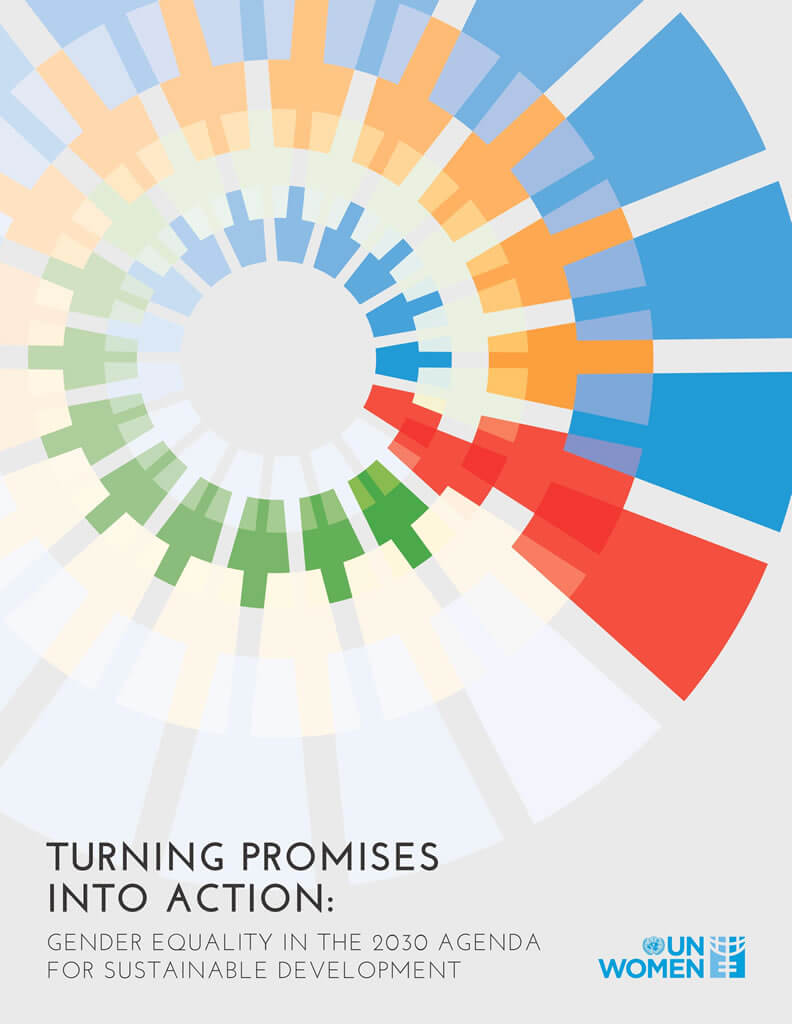Press release: New UN Women report uncovers significant gaps for women’s empowerment and puts forth robust agenda to shift gears
Spotlights inequalities and challenges faced by women; identifies gaps and opportunities for gender equality in the 2030 Agenda for Sustainable Development.Date:
United Nations, New York — UN Women today launched its flagship report, “Turning promises into action: Gender equality in the 2030 Agenda for Sustainable Development”. The report demonstrates through concrete evidence and data the pervasive nature of discrimination against all women and girls everywhere, and puts forth actionable recommendations on how to fulfil the 2030 Agenda for Sustainable Development.
Two and a half years after the adoption of the 2030 Agenda, this first-of-its-kind report examines through a gender lens the progress and challenges in the implementation of all 17 Sustainable Development Goals (SDGs). The Agenda’s focus on peace, equality and sustainability provides a powerful counter-narrative to the current rise of conflict, exclusion and environmental degradation. Yet, women are up against an unprecedented set of challenges in all these areas, and urgent action is needed to address them.
For instance, new analysis from the report shows that:
- In 89 countries with available data, women and girls account for 330 million of the poor. This translates to 4 more women living on less than USD 1.90 a day for every 100 men. The gender gap is particularly wide during the reproductive years.
- More than 50 per cent of urban women and girls in developing countries live in conditions where they lack at least one of the following: access to clean water, improved sanitation facilities, durable housing, and sufficient living area.
- Eliminating all forms of violence against women and girls is a pre-condition for peaceful societies, yet 1 in 5 women under the age of 50 experienced physical and/or sexual violence by an intimate partner in the past 12 months.
- Between 2010 and 2015, the world lost 3.3 million hectares of forest areas. Poor rural women depend on common pool resources and are especially affected by their depletion.
Presenting the report, UN Women Executive Director Phumzile Mlambo-Ngcuka, said: “As a world, we committed through the SDGs to leave no one behind. This report’s new data and analysis underlines that, unless progress on gender equality is significantly accelerated, the global community will not be able to keep its promise. This is an urgent signal for action, and the report recommends the directions to follow.”
The report highlights how, in the lives of women and girls, different dimensions of well-being and deprivation are deeply intertwined: a girl who is born into a poor household and forced into early marriage, for example, is more likely to drop out of school, give birth at an early age, suffer complications during childbirth, and experience violence—all SDGs targets—than a girl from a higher-income household who marries at a later age.
The report also looks beyond national averages to uncover the yawning gaps between women and girls who, even within the same country, are living worlds apart because of their income status, race/ethnicity, or where they live. In the United States, poverty rates among black, Native American, and Alaskan Native women more than double those of white and Asian women, with disparities in education also staggering. Thirty-eight per cent of Hispanic women in the poorest quintile did not complete high school, compared to a national average of 10 per cent. Other case studies and data sets from the report take an in-depth look at the situation in Colombia, Nigeria, Pakistan, South Africa, and Uruguay.
The report also provides wide-ranging recommendations for change, highlighting four key areas of action:
- Integrated policies that can leverage synergies and help achieve several goals at the same time. Achieving gender equality is not only an important goal in and of itself, but also a catalyst for achieving the 2030 Agenda and a sustainable future for all. For instance, the report shows that reducing the burden of unpaid care work for women by providing free and universal child care would allow them to access employment opportunities, create decent jobs in the social services sector, and improve children’s health and nutritional outcomes. And, as simulations for South Africa and Uruguay show, the investment would at least in part pay for itself by generating new jobs and additional tax revenue.
- More and better statistics. Currently, we cannot actually assess what is happening to women and girls across all 17 SDGs. Six of them have no indicators with explicit mentions of women and girls, and the lack of timely and regular gender data hampers adequate monitoring.
- The financing gap to achieve a sustainable world can in fact be closed, by addressing the unrecorded capital flight, including illicit financial flows that developing countries face; by reversing the public expenditure cuts that erode safety nets and essential services in both developed and developing countries; and by using all strategies available for raising domestic revenue.
- Ensuring that those in power are held accountable for gender equality commitments. Indispensable in this effort is a vibrant civil society with space to express itself.
The launch event today in New York will be followed by others in Berlin and Nairobi in the coming days.
The report and its executive summary are available at https://www.unwomen.org/en/digital-library/sdg-report.
Follow the online conversation on Twitter by using the hashtags #PromisesToAction #GlobalGoals, and by following @UN_Women.
